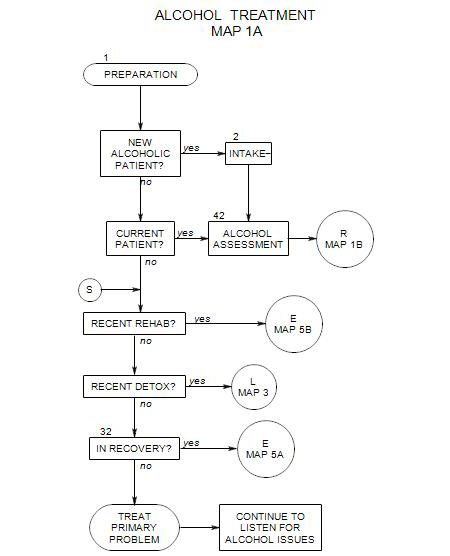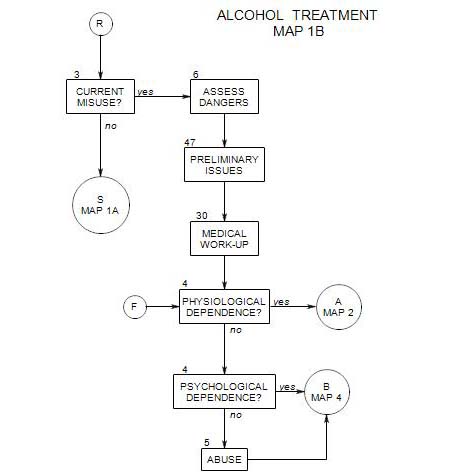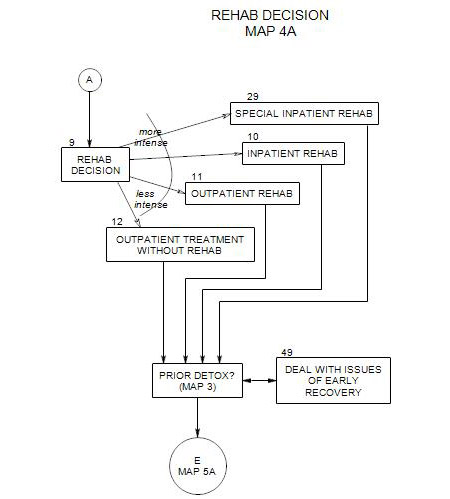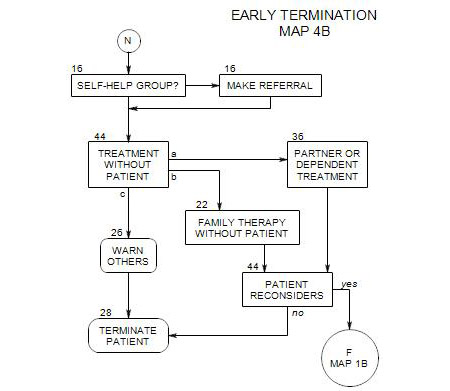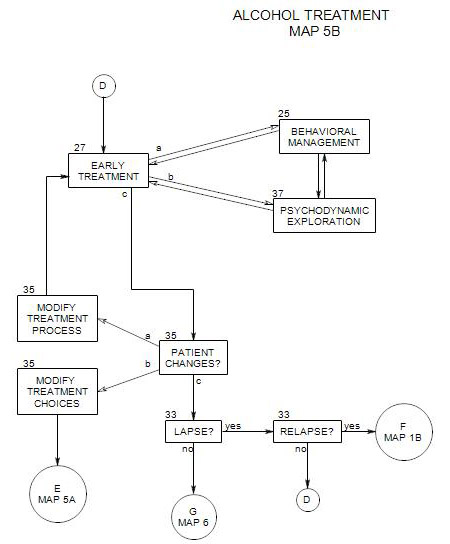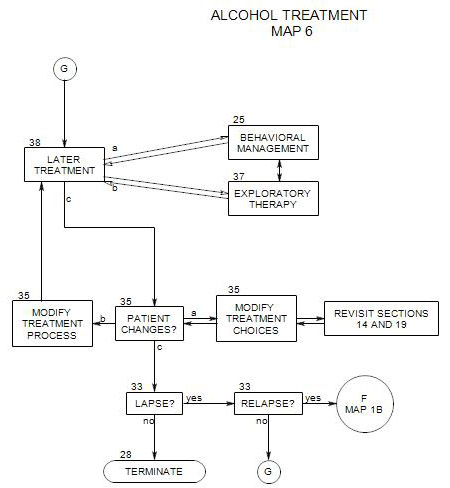35. DEALING WITH PATIENT CHANGES
- This section follows Early Treatment [ Section 27 on Map 5 ], and Later Treatment [ Section 38 on Map 6 ].
The purpose of psychotherapy is to facilitate positive change – change in the way a person sees the world, reacts to others, deals with stress, and so on. Some of changes are entirely psychological, and others have to do with the way the person organizes his or her life or reacts to people and situations.
Because psychotherapy typically addresses both alcohol use and other psychological and interpersonal issues, patients can change in many different ways, and the changes can be either positive or negative. Patient failure to change can also be either positive or negative. Regression, lapses, even relapse can have long term benefits if treatment can adapt and the patient can learn from them.
In the broad course of treatment for alcohol dependence or abuse and a person’s other psychological issues, we hope for slow, steady improvement. The person establishes limits on his/her behavior in order to maintain sobriety, engages in other complementary activities, and solidifies self-awareness to support behavioral changes in drinking.
However, even positive change can increase a person’s stress level; and for some people, increased stress can increase the urge to drink. In addition, circumstances change continually in most people’s lives, and the pressures may increase even while their abilities to cope with them improve. Because of that, progress may not be linear. While we wouldn’t encourage to a patient to have lapses or relapse, if it happens, it doesn’t mean the end of treatment. Patient and therapist can work together to get back on track.
We need to re-evaluate treatment when –
- the patient isn’t improving quickly enough.
- the patient is getting worse or relapsing.
- the patient has improved to the point that another step can be taken.
- sometimes,just because it’s time.
Treatment must also adapt to changes that arise elsewhere in the patient’s life. A therapist’s job includes managing the overall direction of treatment, so that treatment decisions are predicated on the kinds of changes that the patient makes – or doesn’t make. For every change in the patient that you observe during the course of treatment, a decision must be made. Do you
- continue treatment unchanged
- modify treatment choices
- modify treatment process
- deal with a lapse or relapse
Parts of this section include
- Positive changes
- Negative changes
- Treatment modifications
- Change in alcohol focus
- Changes in specific issues
- Identifying changes
- Signs of impending relapse
35a. Positive Changes
A person who stops using alcohol as a coping device has to face new challenges and deal with old ones in new ways. These changes are difficult.
Positive changes could include –
- becoming more open.
- reducing drinking or becoming abstinent.
- reduction in alcohol-associated psychological issues.
- reduction in other psychological issues.
- more serious consideration of the patient’s own part in his/her difficulties.
- opportunities for greater involvement and intimacy.
If things are going well, treatment may continue by slowly expanding the issues considered, continually re-working and consolidating issues previously considered. Depleting old alcohol issues of their power.
35b. Negative Changes
People also regress during treatment, for a variety of reasons, including toe following.
- Their lives change, increasing stress, or reducing their available time or income and ability to support themselves
- They have increased difficulty with the people around them – because others change or because they become more difficult or demanding
- They move away, or drop out of treatment for another reason
- Treatment stirs up issues in ways they can’t manage, and they are tempted to increase their drinking or return to drinking
Because of changes, they may –
- become more dependent.
- have more conflicts with family.
- lapse.
- relapse.
35c. Treatment Modifications
When change occurs in a patient and his/her life, the therapy may need to be modified also. Depending on the changes in the patient,
- the current form of treatment may need to be modified to address new issues, to focus differently, etc. For example, this could occur within individual therapy when the patient’s focus shifts toward handling work pressures as the management of cravings becomes less central.
- the balance between behavioral management and psychodynamic exploration may need to change. In part this is a natural progression of treatment, where early work typically is focused on managing the patient’s drinking behavior, and later on more of the work can be devoted to psychodynamic exploration. The balance might also need to shift in the other direction, if exploratory work is ineffective in helping the patient control his/her drinking behavior.
- the primary form of treatment may need to be changed, permanently or temporarily. One example would be bringing the patient’s partner into couple sessions to deal with issues that can’t be handled individually.
- adjunctive care may need to be modified and possibly increased, by introducing new professional consultations, suggesting individual therapy for other family members, recommending that the patient become involved in a self-help group, etc.
35d. Change in alcohol focus over time
The very fact of talking about alcohol use in therapy will commonly lead a patient to change his/her perspective on drinking. Often this means a reduction in the frequency of drinking or quantities taken in.
Sometimes a patient will reduce or stop drinking as a natural consequence of other changes, and his or her primary reaction will be satisfaction or relief. For other patients, changing drinking behavior may be more difficult, and additional support may be called-for. The change can be eased by
- helping him/her develop a plan for the reduction or a set of ways to cope with the changes
- being more available if needed, with extra sessions and calls outside normal hours. Patients under additional stress generally appreciate a simple offer such as “Feel free to call me if you need to;” and the offer is seldom abused.
- encouraging him/her to participate in a self-help group and find a sponsor
35e. Changes Relative to Specific Issues
EFFECTS ON PARTNER OR FAMILY
As a patient’s dependency on alcohol decreases, s/he may wish to become more of a partner in his/her family or relationship. This can be accepted with relief or suspicion and resistance by others. It may lead to power shifts, as the patient becomes more responsible and cooperative. The effects of other family members on family dysfunction may become more apparent, or other family members may welcome patient changes with support – or both.
Treatment issues include whether to –
- examine the changes with the patient psychodynamically and let him/her deal with the family or couple issues separately.
- help the patient work out behavioral changes with other family members.
- help the patient manage the reactions of others.
- bring the partner in for couple work or the family in for family sessions.
- send the patient and others out for adjunctive couple or family sessions relative to the issues being raised. [See Section 19 for the adjunctive care decision].
TYPE OF MATERIAL ADDRESSED AND TREATED
Ideally, as a patient learns to manage drinking urges behaviorally, therapy can become more psychodynamic, focusing more on issues that may in the past have been avoided by drinking.
35f Termination
Some patients may believe that, because they are stabilized in recovery, the work is done, and not go on to the next step. They may be too concrete in their thinking to benefit from additional psychodynamic exploration. They may have a behavioral bias and not want to look inside for answers. They may be so committed to self-help work that they see additional psychotherapy as unneeded or distracting. These patients may stop
35g. Identifying Patient Changes and the Need to Modify Treatment
Alcohol treatment typically involves both a direct focus on the patient’s involvement with alcohol and work on his or her other psychological, cognitive or interpersonal issues. Each aspect of treatment may require modification from time, as will the balance among them.
It can be helpful to keep a session-by-session written record of themes and the balance of focus for treatment planning purposes. It could look like:
Session % Alc Major Themes and risks
Date Focus
.______ ______ ______________________________________
.______ ______ ______________________________________
.______ ______ ______________________________________
Continual attention should be paid to soft signs of impending relapse. In many cases, the same symptoms that in aggregate can predict relapse can separately signal a need to re-focus the therapy. These could include, for example,
- patient involvement in situations with high risk for emotional challenges or temptation to use alcohol.
- changes in the patient’s family or work environment.
- changes in the patient’s use of psychological defenses.
- mood changes.
For more on the signs to watch for, see Section 33.
